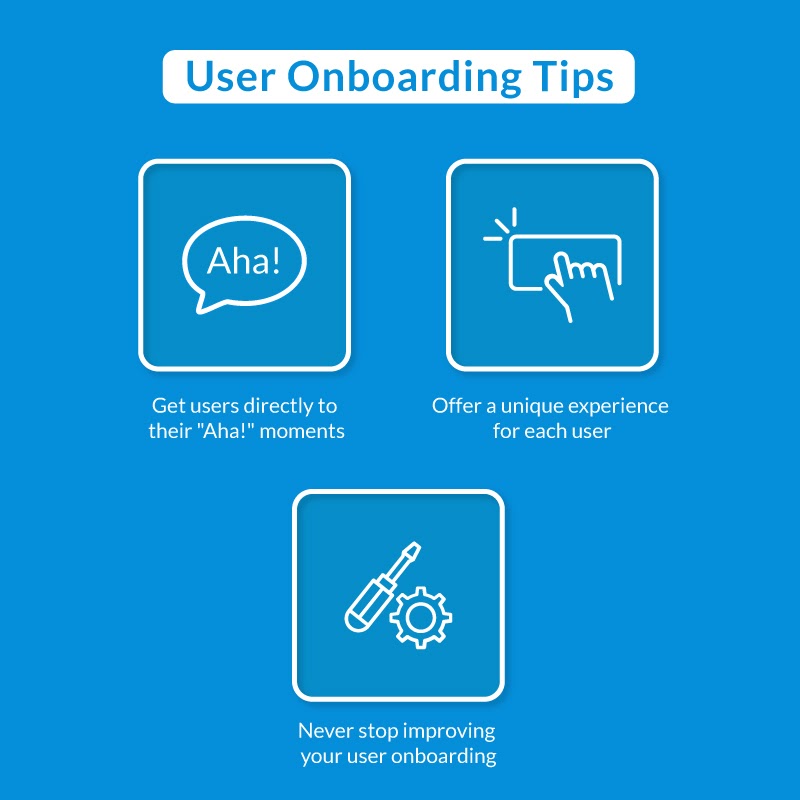
What do you think the most crucial part of a user’s journey is?
You might think it’s the part where they decide to make the purchase, but it’s not.
The most crucial part of a user’s journey is their onboarding to your product.
Because this is the part where the fate of their relationship with your business is decided.
Are they going to stay?
Will they upgrade their plan or purchase other products from you?
Or will they leave your platform?
Each of these questions is answered in this brief period, where they get to know you and your product. But what exactly is user onboarding?
What is User Onboarding?
User onboarding refers to the period of time in a user’s journey where they get acquainted with your business and the product or service you are offering them.
It starts from their initial decision to give your solution a try and ends when they understand the value of your solution and how they can achieve it.
Simple, right?
But most businesses mess this part up and lose customers forever. Why is that, you ask?
It’s mostly because they don’t pay it anywhere near enough attention. It usually takes businesses a long time before they understand that improving and optimizing their user onboarding can fix tons of issues related to their growth and the UX they offer.

Tips for a better User Onboarding
Whether you’re working in a recently founded startup or a billion-dollar tech corporation, you have to start focusing on improving your user onboarding.
The formula is simple:
better onboarded users = increased customer lifetime value = improved revenue
A while ago, we were increasingly acquiring new customers, but we were experiencing a high churn rate as well. Doesn’t matter how many customers you acquire, a high churn rate is a game-breaker because it significantly reduces the amount of value you get from each customer.
We were a bit too confident about our onboarding, so it wasn’t the first place in our UX that we examined. But when we did, we noticed that it hadn’t been updated for a long time and definitely due for a rework.
So we recreated our user onboarding. Our churn rate was reduced by nearly 50% in the following months.
And in this article, I will give you the 3 tips that were the fundamentals of our rework, which worked perfectly for us.
Note that these tips can be applied whether you’re having your own developers build your user onboarding material or you’re using 3rd-party software.

Let’s start with the overall structure of your onboarding:
#1 Make getting users directly to their “Aha!” moments the priority
Most businesses don’t fully comprehend this part.
And you shouldn’t be one of them.
They perceive user onboarding as a step in creating users who are masters of your product, but user onboarding is the entire staircase.
User onboarding is often mistaken as a means to train users on your product and its features. What it should actually do is guide the users along the path you’ve created to their Aha moments.
An Aha moment is the point where a user understands the value you offer and says, “Aha! So THAT’S how this product will contribute to my life”. The reason this point is so important is that, after a user reaches their Aha moment, they are no longer a new user; they are activated, engaged, and already are getting value from your product.
So instead of giving a lock, stock, and barrel training of your product, go over the necessary parts that they need to start to get value from it, to reach their Aha moment.
You won’t convince a user to adopt your product by answering the question, “What happens when I click this?”, but by answering “How can this start adding value to my daily life?”.
Therefore, put value before unnecessary details on your onboarding, highlight a clear path to the Aha moment.
Read all about Aha moments here.
#2 Offer a unique experience for each user
Having mentioned the importance of value, try to answer this yes-no question in 2 seconds:
“Are all of your users getting the exact same value from your product?”
It’s nearly impossible to give the answer “Yes”, even if your product has a single feature.
And what would you say if I told you that different users that aim to get a different value from your product have to go through the same onboarding process and might not even end up receiving the value they’re looking for?
Outrageous, right? It’s like selling a person who lives in the North Pole a straw hat.
So just be reasonable, and give every user an onboarding that leads to the value they’re looking to get.
Start by figuring out the users who are after the same value, group them. These groups are also called user segments based on their needs.
This practice is widely used in sales and marketing, it just isn’t commonly used in user onboarding.
But you must change that. For each of these user segments, your user onboarding should be different. Depending on the product and the segment, there could be a need for making a few changes here and there or designing a new user onboarding from scratch.
It’s all about what the users want with your product, so you need to ensure that every user gets the value they’re looking for at the end of the user onboarding process.
If you create a personalized, unique experience for each user; you’ll be offering the best service possible.
#3 Never stop improving your user onboarding
This is a no-brainer.
Yet one of the most important tips that one can give on user onboarding (or any other concept in life).
There is no such thing as maximum prolificacy in user onboarding, iteration is always possible.
Whatever material you have created, it can be endlessly improved based on the data you get from real users.
The colors in your product tour can be too flashy, the button that you’ve placed in your in-app message might perform better in the other corner, or that third step in your onboarding checklist might be completely unnecessary.
You can’t know without analyzing each material’s performance.
1- Getting analytics in place
The first step of improving anything ever; finding out what to improve!
A user onboarding consists of multiple elements with numerous steps, and every step is not equally optimized for user experience.
Ideally, you want to set up an analytics dashboard that will give you insight on the performance of each step by providing data such as:
- Onboarding completion rate
- Onboarding completion time
- The steps where users drop off
- The steps that took longer than necessary to complete
With a bit of development resources, you can set up complete analytics, or, you can choose a third-party user onboarding tool which would provide you with analytics.
Pinpointing the low performing material will give you room to improve, which brings me to my next point:
2- Making the necessary changes at the right time
You already know how everything performs.
And you’ve got a list of low-performing material that is bound-to-be updated.
Note that I didn’t say “eventually bound-to-be updated”, you need to make some changes right now because you are possibly losing revenue because of that material.
Don’t postpone updating your onboarding, which might not always be possible due to, you know, developers…
Instead of being dependent on the developers, just like creating the onboarding itself, you can edit it by just clicking here and there or dragging and dropping the content you want with a 3rd-party tool.
3- Make optimization a loop, not a one-time task
This is a no-brainer.
I hope this is a no-brainer.
Optimization is never a one-time task that you do once every couple of years and move on.
It has to be done systematically and constantly to get better and better every day. Since most companies don’t focus on optimizing their onboarding, it is hard to expect them to optimize their optimizations.
You should keep trying to find new and better ways to onboard your users for the best results.
Here is another resource around the Perfect Onboarding Experience
Long Story Short
Whatever growth problem you’re experiencing, getting the right user onboarding material can be a way to solve it.
You must always direct users to the value first, before filling them up with unnecessary information.
You must give each user whatever value they are looking for, with an onboarding experience that is customized to them.
And you must never stop improving your user onboarding material to bring out your A-game.
Author name: Selman Gokce Email: selman@userguiding.com
Selman Gokce is the inbound marketing specialist at UserGuiding, an all-in-one and no-code user onboarding platform. He has written many articles on user onboarding and growth and is a product and UX enthusiast, especially the psychology that drives users to try, and adopt products.

